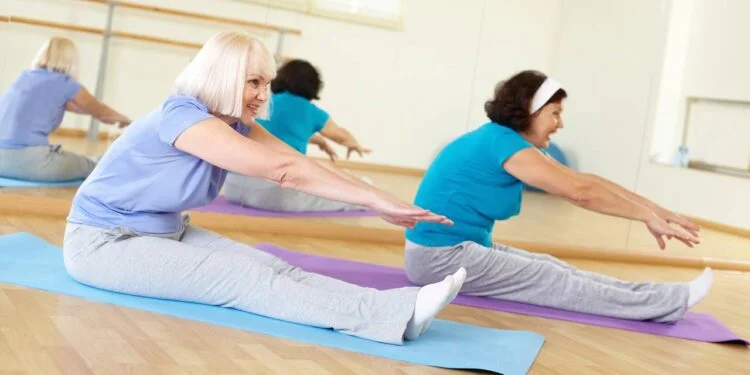Combating Sarcopenia: The Best Exercises 50 Years Old to Preserve Muscle and Independence
Best Exercises 50 Years Old
The 50-year mark signifies a critical transition in physical health, demanding a re-evaluation of exercise routines. It is at this stage that the loss of muscle mass, known as Sarcopenia, and the reduction of bone density, Osteopenia, accelerate, undermining strength, balance, and, consequently, functional independence.
Active aging, however, is not about stopping, but about adapting and prioritizing. As highlighted by Stanford University researchers and corroborated by the Correio Braziliense article, the key lies in an exercise routine that develops three pillars: Strength, Endurance, and Balance. Combining regular practice with adequate nutrition is the only proven way to stimulate the production of myokines (beneficial substances generated by muscle contraction) and combat the metabolic and hormonal changes typical of this phase.
This detailed guide explores the scientifically proven Best Exercises 50 Years Old to reverse muscle loss, shield bones, and ensure that maturity is synonymous with vitality and autonomy.
The Three Essential Pillars of Training in Maturity
An effective workout after 50 must be multifaceted. Walking alone is not enough; the body needs varied stimuli to respond to the natural decline of age.

Pillar 1: Strength Training (Resistance)
Strength Training is, by far, the most crucial element in combating sarcopenia and osteopenia. Intense muscle contraction stimulates protein synthesis (muscle growth) and calcium deposition in the bones.
- Ideal Frequency: 2 to 3 weekly sessions of 40 to 60 minutes are recommended, always with professional supervision, as per Correio Braziliense.
- Myokines and Metabolism: Strength training is vital for metabolic health, as it reduces fat accumulation and aids in hormonal balance (especially important for women in menopause).
- Key Exercises: The focus should be on compound movements (which use multiple muscles), such as Squats, Push-ups, and Rows, which work large muscle groups. Examples include Chair Squats (for safety) and Dumbbell Rows (for posture).
Pillar 2: Balance and Mobility (Functionality)
With aging, the risk of falls increases due to the loss of proprioception and stabilizing strength. Exercises that challenge balance are indispensable for maintaining functional independence.
Pilates: With sessions of 40-50 minutes, 3 to 4 times a week, Pilates strengthens the Core, improves posture, and increases flexibility and body awareness. It is excellent for protecting the spine and improving overall mobility.
Gentle Martial Arts (e.g., Tai Chi): Tai Chi is specifically highlighted for balance. The practice, performed several times a week, improves coordination, leg strength, and drastically reduces the fear and risk of falls. The slow, conscious movements are ideal for those starting out or with joint limitations.
READ ALSO:
- Does Running Help You Lose Weight? How to Start and Progress Without Losing Your Breath
- Mika Takishima Method: 4 Transformative Exercises for Weight Loss and Healthy Aging
Follow our PAGE
Aerobic and High-Intensity Exercises
While strength is the priority for muscle combat, cardiovascular health and aerobic capacity cannot be neglected.
Fast and Long-Duration Walking
Walking is the foundation of aerobic exercise: simple and low-impact.
- Recommendation: Brisk walks of 30 to 60 minutes, performed several times a week.
- Benefits: Improves cardiovascular health and endurance, in addition to being an activity that promotes mental well-being and is easy to adhere to.
High-Intensity Interval Training (HIIT)
HIIT may seem intimidating, but, when adapted and supervised, it promotes expressive improvements in strength, cardiovascular health, and, surprisingly, Muscle Mass.
- Adaptation: HIIT for mature adults is not about maximum speed, but about relatively intense effort peaks, followed by active recovery.
- Frequency: 20 to 30 minutes, twice a week, always with professional guidance. Controlled intensity maximizes aerobic capacity and sarcopenia prevention, as pointed out by Correio Braziliense.
Assembling Your Training Plan for Maturity
The key element for success is Variety and Progression. Never do the same workout repeatedly, nor disregard supervision.
Phases of an Ideal Weekly Workout
- 2 to 3 Days of Strength/Resistance: Focus on compound functional exercises (Squats, Rows, Pull-downs, Presses) with adequate load to cause fatigue.
- 2 Days of Balance/Mobility: Integrate Pilates, Yoga, or Tai Chi to stabilize the Core, improve posture, and joint flexibility.
- 2 Days of Cardio/Endurance: Combine brisk walking with short, supervised HIIT sessions.
Key Elements for Success
- Professional Supervision: Training with the guidance of coaches or physical therapists is fundamental to ensure adequate technique and personalize progression, preventing injuries.
- Adequate Nutrition: Exercise alone does not reverse sarcopenia. The adequate intake of protein (essential for muscle synthesis) and calcium/vitamin D (essential for bone health) must accompany the increase in physical activity.
- Persistence: Maintaining functional autonomy requires persistence in exercises and balanced eating habits over the years.
Conclusion
Combating muscle and bone loss from age 50 requires an intelligent and diverse training strategy. The Best Exercises 50 Years Old are those that combine the fundamentality of Strength Training (to reverse sarcopenia and osteopenia), the precision of Pilates/Tai Chi (to improve balance and prevent falls), and the metabolic boost of adapted HIIT. By integrating these pillars into your routine, always with supervision, you will be actively investing not only in more years of life, but in more life with quality, strength, and total independence.

Hello! My name is Alan Teixeira and I am passionate about helping people live healthier, more balanced lives. From mindful eating to daily habits that promote physical and mental well-being, I believe that small, consistent changes can lead to powerful transformations.
I created this blog to share practical tips, reliable information, and thoughtful insights that can inspire you to take better care of yourself—with balance, mindfulness, and positivity.
If you are looking to improve your health, nourish your body, and build a lighter, more fulfilling routine, you are in the right place. Welcome!





